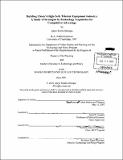Building China's high-tech telecom equipment industry : a study of strategies in technology acquisition for competitive advantage
Author(s)
Smith-Gillespie, Aleyn, 1976-
DownloadFull printable version (12.21Mb)
Other Contributors
Massachusetts Institute of Technology. Technology and Policy Program.
Advisor
Alice H. Amsden.
Terms of use
Metadata
Show full item recordAbstract
Over the past decade, China has witnessed a rapid growth in its information and communications technology (ICT) sector. The subject of this thesis specifically focuses on the telecommunications infrastructure equipment industry in China. This sector is an interesting one to study given that some of the leading domestic companies have mostly emphasized developing their own capabilities in product development, rather than calling upon formal technology transfers through foreign direct investment (FDI) initiatives. A significant challenge faced by local firms, however, is that foreign equipment manufacturers possessing deeper technological resources dominate their domestic market. Nevertheless, Chinese enterprises have recently begun producing high-end equipment such as core/backbone routers and DWDM optical transmission systems. The basic question this thesis seeks to answer, therefore, is how can Chinese companies become technologically competitive within the high-end segments of the telecom equipment market? A case study methodology was used to address this question, focusing on two leading domestic firms: Huawei Technologies, a privately owned company, and ZTE Corporation (Zhongxing), a state-owned enterprise. The findings show that four factors have contributed to the competitiveness of domestic firms. Firstly, they are able to successfully leverage the configurational nature of communications technology. Secondly, the substantial investment made by the case study firms to develop their own R&D capabilities has enabled them to become 'close followers' of the world technological frontier. Thirdly, the global trend towards a less vertically integrated equipment industry has produced a base of suppliers from which Chinese firms can procure world-class component and subsystem technologies. Lastly, the role of the Chinese government has been instrumental in building technological capabilities at the national level and expanding market demand. Reciprocal arrangements and performance requirements established between government and domestic firms have encouraged the latter to upgrade their technological capabilities. These combined observations provide a perspective on firm competitiveness in high tech industries that is somewhat different to the models proposed under 'second mover advantage' theory. Furthermore, the analyses made of technology acquisition at the level of the firm highlight the importance of independent development (where possible), compared to FDI, as a vehicle for technological development within late industrializing economies.
Description
Thesis (M.C.P.)--Massachusetts Institute of Technology, Dept. of Urban Studies and Planning; and, (S.M.)--Massachusetts Institute of Technology, Technology and Policy Program, 2001. Includes bibliographical references (p. 171-175).
Date issued
2001Department
Massachusetts Institute of Technology. Department of Urban Studies and Planning; Technology and Policy ProgramPublisher
Massachusetts Institute of Technology
Keywords
Urban Studies and Planning., Technology and Policy Program.